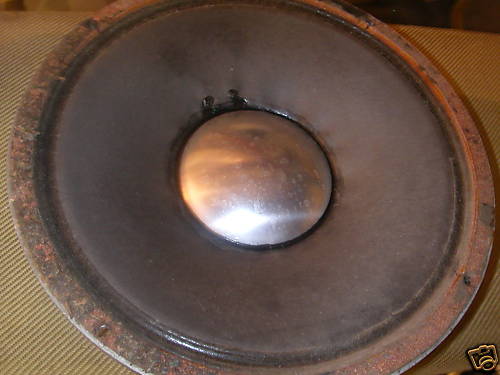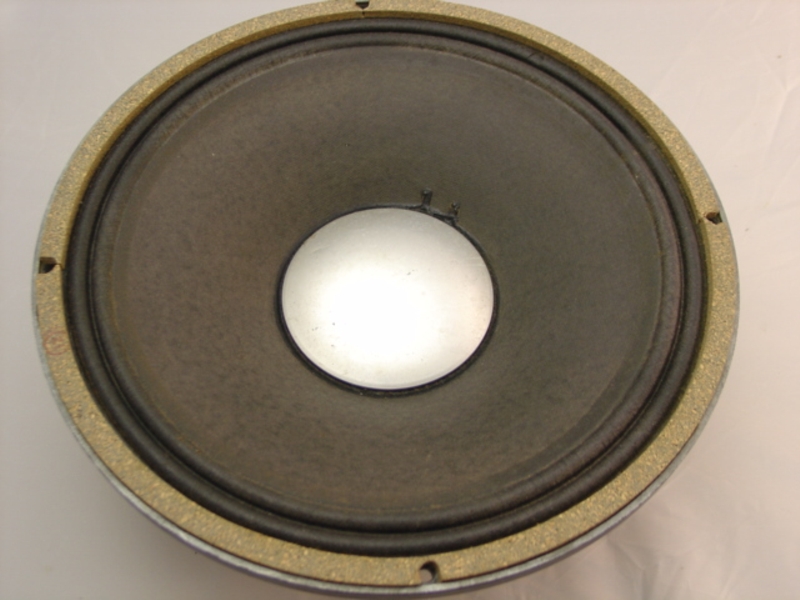There is a swirling controversy about JBL D series and K series speakers involving the speaker cone. Many D series JBLs are showing up with K paper on them, and then being passed off as "origianl cone" or "never reconed" to the unsuspecting public. The sad reality is that in excess of 90% of all D series speakers in circulation have been reconed with K paper.
I have been using JBL speakers since 1970, well before the introduction of the K series speaker. I have owned D-120s, D-130s and at least 2 D-140s, all in original condition, some purchased brand new, if memory serves. So I absolutely know the differences between the D and K series speaker cones from personal experience beginning before K speakers were ever on the market. Production of the D series speakers, both grey and Fender "branded" orange, ceased in about 1972-3. The K series speakers, introduced a year later, were always black framed, with no known exceptions I have been able to find.
The functional reality is the fact that while the motor structure on D and K series speakers remained essentially unchanged, the cone and surround are markedly different. The following images of the D & K series speakers are from my personal collection (not downloaded from the Internet), and the differences can be clearly seen.
The orange framed D series speakers were so coloured for Fender and the "F" designation after the D-120 (D-120F) was simply a reference that these specifically
tagged speakers were slated for Fender amps. If you have heard anything about the orange framed speakers being somehow different than the grey framed speakers, you
have been feed a load of hooey. There is absolutely no difference between the two. Whether they actually got into the amps or not can be debated forever. D series
speakers were commonly grey framed for the general market and Fender amps (Deluxe, Showman, Twin, et al) were initially outfitted with the grey framed D series
speakers, usually by special order. In my experience, about the time the orange frame was introduced, you could get Fender amps with JBLs as an "upgraded" version,
which often had a JBL emblem in the lower right corner of the speaker grill.

In the first image, the D series speaker, you can clearly see the surround is actually a continuation of the cone paper itself, out to the mounting lip and under the cork
at the edge. It is not as sophisticated, and therefore weak by design, and prone to blow out at higher volume or square wave abuse. In this respect, it is very much
constructed like Celestions, Emminence and similar designs of the era. Altec was an exception and a good example you can look at is the model 417B with a "corrugated"
style surround that was very strong as surrounds go.

In the K series, you can clearly see the difference. The cone joins to a cloth surround that has a "double bump" design, which is also doped for added strength,
thereby overcoming the shortfall that was the flaw in the D series surround design. This was a vast improvement and resulted in fewer blown speakers.
More confusion reigns because the cone code is the same for both speakers. This is probably due to the reality that the D series had been discontinued and the product code was convenient. And since the new cone design would retrofit the D series, there really was no reason to change the code. However, close examination of the paper on an original cone D reveals it is somewhat thinner than the newer K paper, which does affect the tone and so results in distortion being introduced at lower volumes.
This difference gives the D series a characteristic sound different than the K series. While it is cleaner than most of its contemporary competitors, Jensen, Celestion, CTS, Emminence, et al, cone "break up" could still be achieved before ear splitting volumes were reached. This is part of what made them so desirable in Fender amps, they stayed cleaner, and so drove the sound better into the higher volumes. For example, my D-120 (with original cones) equipped 1969 Fender Twin Reverb stays very clean up to around 6 and then begins to break up a little. At full throttle, it breaks up very nice, with the compression of the 6L6 tubes helping keep that distortion nice and warm.
The voice coil on the D series was 4" in diameter and composed of edge-wound aluminum; and the wattage was a solid 100 watts, based on enclosure loading, quality of signal, and other factors. In a Marshall or Hiwatt cabinet, the results were, well, devastating. Just listen to the Allman Brothers at Filmore to hear Duane Allman's Marshall amps drive the D-120 equipped 4-12 cabinets he played through. The only real competition at the time came from Altec, Electro Voice and Cetec Gauss.
With the introduction of the K series, the wattage remained at 100W RMS, with the same 4" diameter edge wound aluminium coil. Because of improvements in the cone material and slightly increased thickness, distortion was "pushed back" making the speaker work cleaner at even higher volumes. Of course, beyond a certain point, the speaker is going to "break up", just like any other hard driven speaker.
I run a Hiwatt DR-103 through JBL K-120s and it is stunning. The clean nature of the Hiwatt through clean speakers at concert hall volumes is magic. A Hiwatt is a hard amp to get a handle on because it is so different than Marshalls, far cleaner at higher volumes, and so more difficult to master. Mated with K-120s, this combination encourages the pursuit of tone. Without that commitment, it's just a very loud amp... and not so pleasing to the ear.
More recently Weber VST has been doing a very fine recone on the D-120, even finally coming close to a perfect match in their kit to the original, preserving the orignal character of the speaker. These reconed D-120 speakers are beginning to show up in the market place. You can still tell the difference. But the truth is this: if your D series speaker has K recone kit, you basically have a K series speaker now - all because the motor structure of the D and K series is identical. So if you want the D series "sound", you will have to have the speaker reconed through Weber, one of a very few companies I am aware of that does the closest job of matching the "original" cone material (including the flaw of full paper surround). And they do great work.
I recently had the pleasure of playing through Weber's version of the D-110 speaker. It is a 10" speaker. And it does a very nice job of capturing that sound of the originals. It's not quite the same - nothing that emulates the original will ever be exactly the same - but it does a very commendable job of "chasing" that long lost tone only JBL used to produce.
I hope this clears up the mess people are making of this issue. It may seem petty. But for people who know these things - and I've been in the music business for well over 40 years, having bought and used original D series speakers from the dealer as original purchaser - it is about accuracy in reporting and during the resale process. Be educated, and don't be snookered by people who don't know what they're talking about!